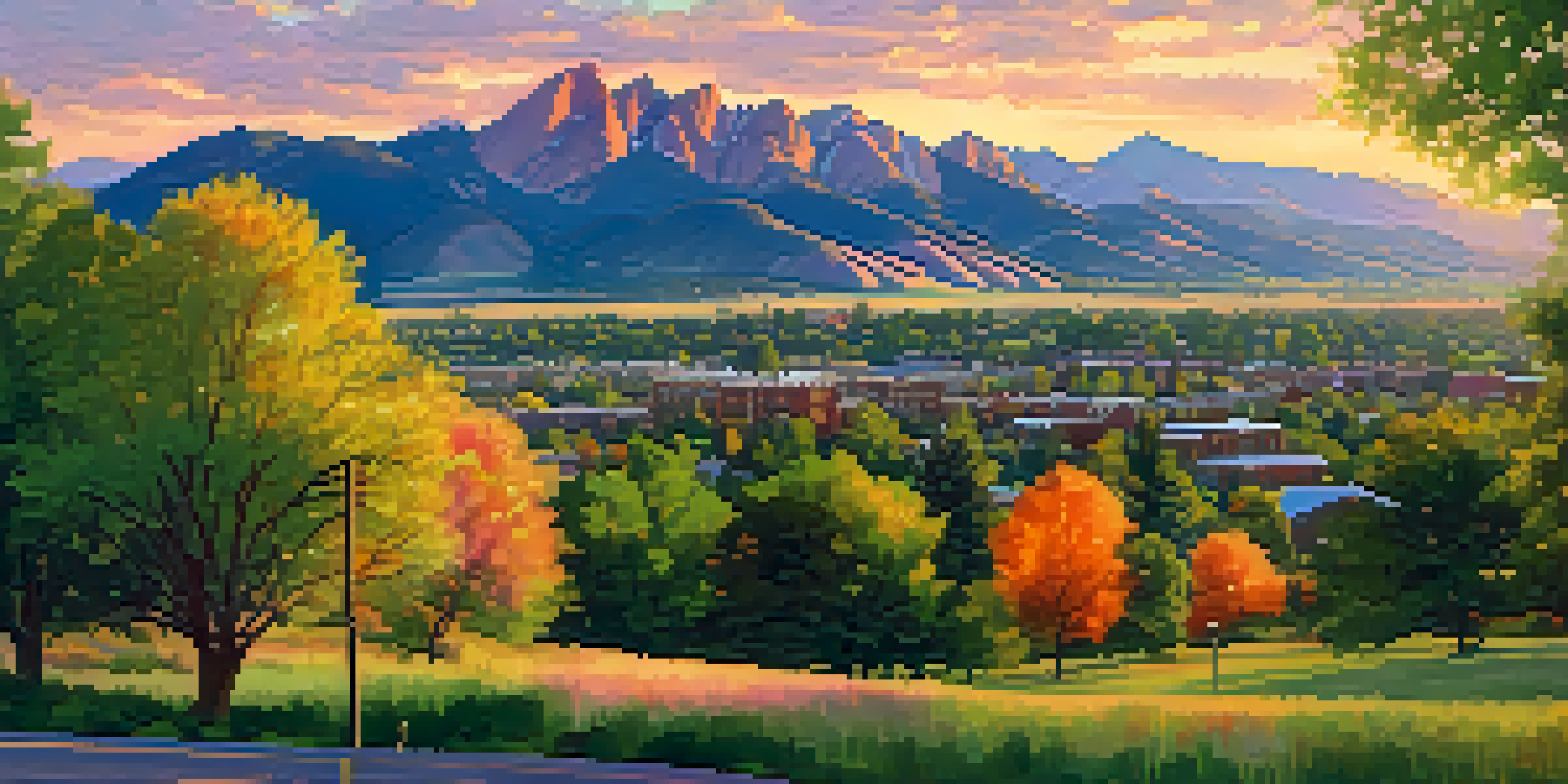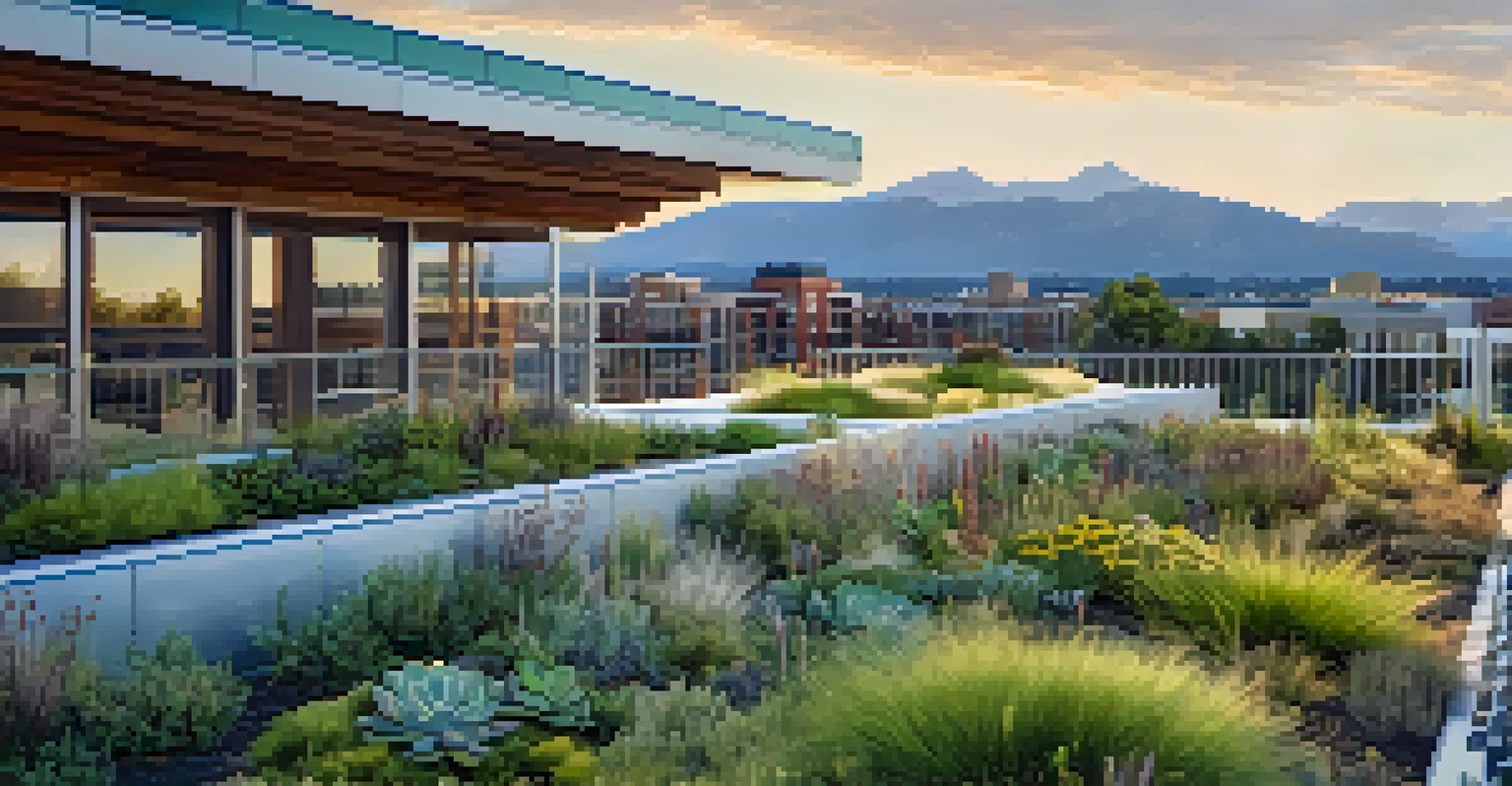Urban Development and Boulder's Unique Climate Intersection

Understanding Boulder's Unique Climate Challenges
Boulder, Colorado, is renowned for its stunning landscapes and vibrant community, but its climate presents unique challenges for urban development. With its high altitude and varying temperatures, the city experiences a range of weather patterns that influence building designs and infrastructure. For example, the cold winters and warm, dry summers necessitate energy-efficient solutions to ensure comfort year-round.
Sustainable urban development is about creating places that are resilient, adaptable, and reflective of the community's values.
Moreover, Boulder often faces the risk of wildfires and flooding, making it essential for urban planners to consider these factors in their development strategies. Implementing fire-resistant materials and creating adequate drainage systems are just a couple of ways to mitigate these risks. This foresight not only protects residents but also enhances the long-term sustainability of the city.
In summary, understanding Boulder's climate is crucial for effective urban planning. By addressing these unique challenges, developers can create spaces that are not only functional but also resilient, ensuring that Boulder remains a desirable place to live and work.
Integrating Sustainable Practices in Urban Design
Sustainability is at the heart of Boulder's urban development approach. The city prioritizes eco-friendly practices that minimize environmental impact while enhancing the quality of life for its residents. For instance, the use of green roofs and permeable paving helps manage stormwater runoff and reduces the heat island effect, which is especially important during the summer months.

Additionally, Boulder's commitment to renewable energy sources, such as solar and wind, is reflected in its building codes and zoning regulations. These initiatives not only lower carbon footprints but also encourage community engagement in sustainability efforts. Residents are often motivated to participate in programs that promote energy efficiency and conservation.
Boulder's Climate Shapes Urban Planning
The unique climate challenges in Boulder necessitate innovative building designs and infrastructure to ensure resilience and comfort.
Overall, integrating sustainable practices in urban design not only addresses climate concerns but also fosters a sense of community. Boulder's emphasis on eco-friendly development creates a living environment that aligns with the values of its residents and protects the natural beauty of the area.
The Role of Public Transportation in Urban Growth
Public transportation is a vital component of Boulder's urban development strategy. With the city's commitment to reducing traffic congestion and greenhouse gas emissions, enhancing public transit options is essential. Boulder's transit system includes buses and bike-sharing programs that connect neighborhoods, making it easier for residents to commute without relying on cars.
The best way to predict the future is to create it.
By improving public transportation, Boulder aims to create a more accessible city for everyone. This not only benefits those who may not own vehicles but also encourages a healthier lifestyle by promoting walking and cycling. As a result, we're seeing a growing focus on creating pedestrian-friendly spaces that enhance community interactions.
In a nutshell, the role of public transportation in Boulder goes beyond mere convenience; it’s about building a cohesive community. By investing in transit, Boulder fosters a culture of connectivity and environmental consciousness, which is crucial for its ongoing urban development.
Balancing Growth and Preservation in Urban Areas
Boulder faces the constant challenge of balancing urban growth with the preservation of its natural environment. As the city expands, it is essential to protect the breathtaking landscapes and ecosystems that define its character. This is achieved through careful zoning laws and land-use planning that prioritize open spaces and green belts.
Community input plays a significant role in this process. Residents often engage in discussions and workshops to voice their opinions on potential developments, ensuring that growth aligns with the community’s values. This collaborative approach helps create a shared vision for the future of Boulder, where development and preservation coexist harmoniously.
Sustainability Drives Urban Development
Boulder's commitment to eco-friendly practices not only minimizes environmental impact but also enhances community engagement and quality of life.
Ultimately, finding this balance is crucial for maintaining Boulder's unique identity. By fostering a culture of collaboration and respect for the environment, the city can grow while still honoring the natural beauty that attracts so many people.
Innovative Architecture: Responding to Climate Needs
The architectural landscape in Boulder reflects a commitment to innovation that responds to its unique climate. Many buildings feature designs that harness natural light and ventilation, reducing the need for artificial heating and cooling. For example, homes often incorporate large windows and open layouts to maximize energy efficiency and comfort.
Moreover, the use of sustainable materials is on the rise. Structures built with reclaimed wood, recycled materials, and low-impact construction methods not only support environmental goals but also offer a distinct aesthetic that resonates with the local culture. This innovative architecture contributes to a sense of place and community pride.
In essence, Boulder's approach to architecture illustrates how urban development can embrace climate considerations. By prioritizing innovative designs that meet environmental needs, the city sets a standard for sustainable living that can inspire other communities.
Community Engagement in Urban Development
Community engagement is crucial in shaping Boulder's urban development initiatives. Local residents are encouraged to participate in planning processes, ensuring that their voices are heard when it comes to the future of their neighborhoods. Public meetings and online forums provide platforms for discussions about new projects and policies.
This active involvement not only fosters a sense of ownership among residents but also leads to more informed decision-making. When community members contribute their insights and experiences, urban planners can develop solutions that truly meet the needs of the population. This collaboration creates a stronger, more connected community.
Community Input is Essential for Growth
Engaging residents in the urban planning process ensures that developments align with community values and aspirations, fostering a stronger connection among citizens.
Ultimately, community engagement transforms urban development from a top-down approach to a more inclusive process. By valuing residents' input, Boulder can create spaces that reflect the collective vision and aspirations of its community, ensuring that development benefits everyone.
Future Prospects for Boulder's Urban Development
As Boulder looks to the future, its urban development strategies are evolving to address the challenges and opportunities presented by climate change. With a focus on resilience, the city is exploring new technologies and practices to adapt to shifting weather patterns and environmental concerns. This proactive approach will help ensure that Boulder remains a vibrant and livable city.
Moreover, ongoing collaboration between city officials, developers, and community members is key to successful urban development. By continuing to prioritize open dialogue and shared goals, Boulder can navigate the complexities of growth while preserving the essence of what makes it unique. The involvement of diverse stakeholders will contribute to more innovative and effective solutions.

In conclusion, Boulder's future in urban development is bright, driven by its commitment to sustainability, community engagement, and resilience. As the city embraces these principles, it sets a powerful example for other urban areas facing similar challenges, proving that thoughtful development can lead to thriving communities.